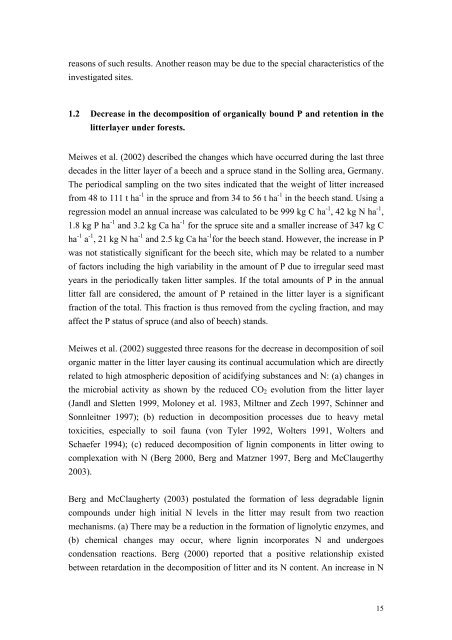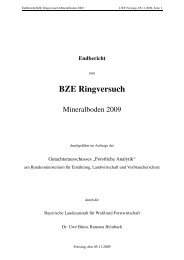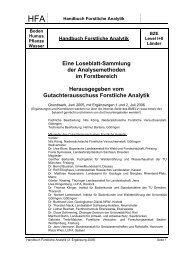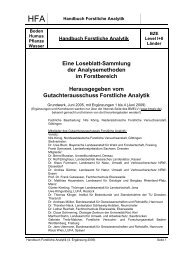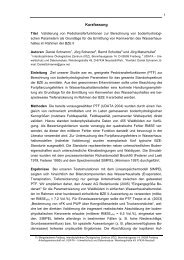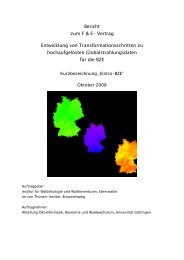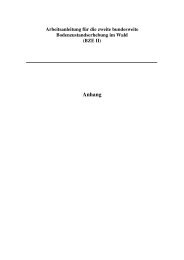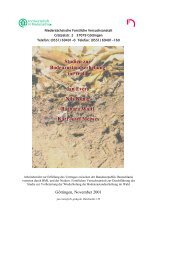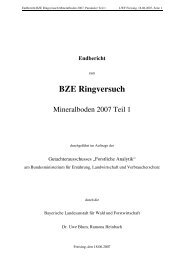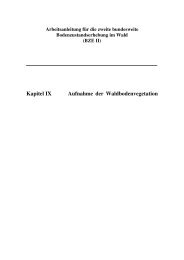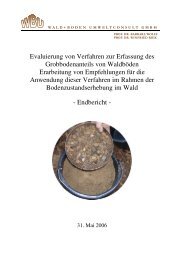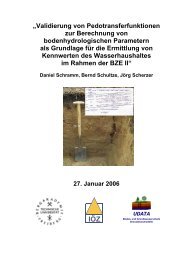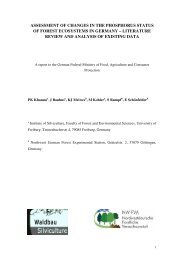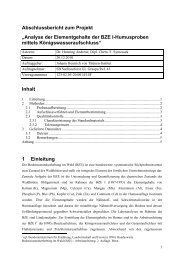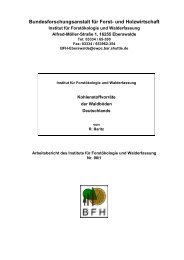assessment of changes in the phosphorus status of forest ...
assessment of changes in the phosphorus status of forest ...
assessment of changes in the phosphorus status of forest ...
Create successful ePaper yourself
Turn your PDF publications into a flip-book with our unique Google optimized e-Paper software.
easons <strong>of</strong> such results. Ano<strong>the</strong>r reason may be due to <strong>the</strong> special characteristics <strong>of</strong> <strong>the</strong><br />
<strong>in</strong>vestigated sites.<br />
1.2 Decrease <strong>in</strong> <strong>the</strong> decomposition <strong>of</strong> organically bound P and retention <strong>in</strong> <strong>the</strong><br />
litterlayer under <strong>forest</strong>s.<br />
Meiwes et al. (2002) described <strong>the</strong> <strong>changes</strong> which have occurred dur<strong>in</strong>g <strong>the</strong> last three<br />
decades <strong>in</strong> <strong>the</strong> litter layer <strong>of</strong> a beech and a spruce stand <strong>in</strong> <strong>the</strong> Soll<strong>in</strong>g area, Germany.<br />
The periodical sampl<strong>in</strong>g on <strong>the</strong> two sites <strong>in</strong>dicated that <strong>the</strong> weight <strong>of</strong> litter <strong>in</strong>creased<br />
from 48 to 111 t ha -1 <strong>in</strong> <strong>the</strong> spruce and from 34 to 56 t ha -1 <strong>in</strong> <strong>the</strong> beech stand. Us<strong>in</strong>g a<br />
regression model an annual <strong>in</strong>crease was calculated to be 999 kg C ha -1 , 42 kg N ha -1 ,<br />
1.8 kg P ha -1 and 3.2 kg Ca ha -1 for <strong>the</strong> spruce site and a smaller <strong>in</strong>crease <strong>of</strong> 347 kg C<br />
ha -1 a -1 , 21 kg N ha -1 and 2.5 kg Ca ha -1 for <strong>the</strong> beech stand. However, <strong>the</strong> <strong>in</strong>crease <strong>in</strong> P<br />
was not statistically significant for <strong>the</strong> beech site, which may be related to a number<br />
<strong>of</strong> factors <strong>in</strong>clud<strong>in</strong>g <strong>the</strong> high variability <strong>in</strong> <strong>the</strong> amount <strong>of</strong> P due to irregular seed mast<br />
years <strong>in</strong> <strong>the</strong> periodically taken litter samples. If <strong>the</strong> total amounts <strong>of</strong> P <strong>in</strong> <strong>the</strong> annual<br />
litter fall are considered, <strong>the</strong> amount <strong>of</strong> P reta<strong>in</strong>ed <strong>in</strong> <strong>the</strong> litter layer is a significant<br />
fraction <strong>of</strong> <strong>the</strong> total. This fraction is thus removed from <strong>the</strong> cycl<strong>in</strong>g fraction, and may<br />
affect <strong>the</strong> P <strong>status</strong> <strong>of</strong> spruce (and also <strong>of</strong> beech) stands.<br />
Meiwes et al. (2002) suggested three reasons for <strong>the</strong> decrease <strong>in</strong> decomposition <strong>of</strong> soil<br />
organic matter <strong>in</strong> <strong>the</strong> litter layer caus<strong>in</strong>g its cont<strong>in</strong>ual accumulation which are directly<br />
related to high atmospheric deposition <strong>of</strong> acidify<strong>in</strong>g substances and N: (a) <strong>changes</strong> <strong>in</strong><br />
<strong>the</strong> microbial activity as shown by <strong>the</strong> reduced CO2 evolution from <strong>the</strong> litter layer<br />
(Jandl and Sletten 1999, Moloney et al. 1983, Miltner and Zech 1997, Sch<strong>in</strong>ner and<br />
Sonnleitner 1997); (b) reduction <strong>in</strong> decomposition processes due to heavy metal<br />
toxicities, especially to soil fauna (von Tyler 1992, Wolters 1991, Wolters and<br />
Schaefer 1994); (c) reduced decomposition <strong>of</strong> lign<strong>in</strong> components <strong>in</strong> litter ow<strong>in</strong>g to<br />
complexation with N (Berg 2000, Berg and Matzner 1997, Berg and McClaugerthy<br />
2003).<br />
Berg and McClaugherty (2003) postulated <strong>the</strong> formation <strong>of</strong> less degradable lign<strong>in</strong><br />
compounds under high <strong>in</strong>itial N levels <strong>in</strong> <strong>the</strong> litter may result from two reaction<br />
mechanisms. (a) There may be a reduction <strong>in</strong> <strong>the</strong> formation <strong>of</strong> lignolytic enzymes, and<br />
(b) chemical <strong>changes</strong> may occur, where lign<strong>in</strong> <strong>in</strong>corporates N and undergoes<br />
condensation reactions. Berg (2000) reported that a positive relationship existed<br />
between retardation <strong>in</strong> <strong>the</strong> decomposition <strong>of</strong> litter and its N content. An <strong>in</strong>crease <strong>in</strong> N<br />
15


